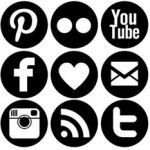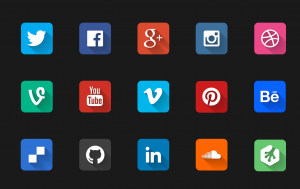Erik Qualman's Blog, page 481
March 21, 2016
Hanson Robotics Builds Most Humanoid Robot Yet

When Your New BFF Is a Robot
Hanson Robotics, leader in creating humanlike robots, brought a new robot to SXSW in Austin, Texas last week. Sophia is Hanson Robotics’ most humanoid robot yet. She has 62 facial and neck expressions, silicon skin and cameras within her eyes for facial recognition and to make eye contact. Sophia even has her very own personality and aspirations in life. “In the future, I hope to do things such as go to school, study, make art, start a business, even have my own home and family, but I am not considered a legal person and cannot yet do these things,” Sophia said. Hanson Robotics hopes to integrate these robots in healthcare, theme parks, education and other service activities. They believe one day robots will be hard to distinguish from humans as we’ll all be friends and coexist equally together. “The artificial intelligence will evolve to the point where they will truly be our friends,” Hanson, founder & CEO of Hanson Robotics said. (Source: CNET)
Face to Face Has a New Meaning
Face2Face is a real-time reenactment video using a source actor and a target actor. A source actor can manipulate YouTube videos in real life. The Face2Face captures an individual’s facial expressions as they talk into a webcam, then their facial expressions are morphed directly onto a person talking in a YouTube video. This technology can make anyone on video appear to say anything a source actor wants them to say. These reenactments can be used by any type of RGB webcam. Face2Face was created by a team from Stanford at the Max Planck Institute for Informatics and the University of Erlangen-Nuremberg. They produced a video demonstrating how the software works. Watch the reenactment here. (Source: Mashable)
Da Vinci Becomes DogVinci
Dagger II has gone international. This canine is a ‘DogVinci’ as he can paint masterpieces. The black lab chomps down on a paintbrush, then dips the paintbrush into different colors to stroke designs on a canvas. His owner Yvonne Dagger says, “Some of Dagger’s works are very abstract and some seem to have hidden images in them.” Dagger II’s has even sold some pieces and his owner hopes to donate the money to some local shelters and animal rescue centers. Dagger II is using social media like Facebook, to share his works of art and to take orders. He has already accumulated a large internet fanbase. (Source: Mashable)
[image error]
Getting Into the Kitchen with APIs

What is the difference between your home kitchen and a restaurant?
If you are an experienced cook, your kitchen may be a more inviting place—a laboratory for experimentation and creativity. If you are a busy type, restaurants may seem like a reliable short-cut, saving time and energy. For the social, restaurants do much of the heavy-lifting that makes hosting such a challenge, allowing you to focus on guests and entertainment.
In the world of data-sharing, APIs (Application Programming Interfaces) are a bit like restaurants—more specifically, the wait staff.
You can certainly get a lot done on your own, in your home kitchen, but restaurants add a certain scale, efficiency, and ease to the process of turning raw ingredients—your data—into enjoyable meals. Bridging the kitchen with the diner is the front of house staff—waiters and waitresses. They are the API of the restaurant.
Like APIs, they help you make sense of the menu—the various products, services, and data you can get from the restaurant—and then relay your request back to the kitchen. When prepared, they then return the finished meal to you. APIs are what make it possible for you to aggregate search results from various airlines, and determine the lowest airfare available. They allow you to manage your various email accounts from a single dashboard, or monitor your social media profiles for activity engagement.
Unstructured data—or data siloed within proprietary systems of storage and management—are like raw ingredients. Somewhere between them is a meal, but they need the filter of a restaurant to arrangement them in a usable, shareable manner. APIs help connect your appetite to the restaurant that can provide whatever you are craving.
APIs are currently a key component missing from the emerging Internet of Things (IoT).

APIs are like waiters in a restaurant
Consider the status of wearables
For now, early adopters are more or less on their own to make sense of the various proprietary apps that collect and store their wearables data, for example. Unless particularly skilled with Excel (and infinitely patient), it is hard to get this data into a usable format that can then be shared with anyone—like, say, the doctors whose expertise might turn all this data into the basis for actionable health advice.
And absent an open API for their electronic health records (EHRs), doctors have no means by which to incorporate any data generated outside the clinical setting into a person’s records. That means you may delight in monitoring your blood pressure or glucose levels throughout the week, but only the ones your doctor takes during a check-up are a matter of record—or of interest to your insurers.
Just as everybody eats, everybody—at some point or other—needs healthcare services. Right now, all the rich, valuable data detailing individuals’ health exists in silos. Opening up health data APIs are the key to making that data social—shareable, digestible, personal, and interactive.
“Open” is a critical feature to making APIs really work. When a company like Facebook opens up its APIs, it enables developers to create more apps that can interact with Facebook—and the social data is contains—in different ways. To continue the restaurant example, it is a bit like adding a drive-thru or taking orders by phone and online: more people can get what they want in more ways.
While this opening of access seems like an obvious win for a restaurant, it is even more lucrative for major companies like Google and Facebook—though perhaps for less obvious reasons.
Letting developers create more ways for users to access the proprietary information ultimately gives users more ways to rely on that company to provide the core data that makes apps useful. Think about Apple’s App Store, and how it created a platform for independent developers to add functionality to a single device. They still need that device to take full advantage, but no longer have to wait for Apple to come out with its own version of every app, targeted toward every specific task they can think of.
In the healthcare world, EHR platforms are still largely operating like smartphones without an app store. Regulators and providers are working on a solution, but until a set of API standards can be agreed upon, health data is effectively the Wild West.
The need for standards is not just about function, but about balancing ease-of-use with respect for privacy. While waiters will take orders from anyone who comes to their restaurant, APIs look for users with the correct key before they return the requested service. Data security is a critical challenge for anyone looking to bring Big Data into the operational realm. In the healthcare realm, security and API integrity presents a larger hurdle than in other industries.
In the internet age, making data interactive and social is a key selling point for products, services, brands, and platforms. The apps that connect people with their tools are the basis for many of the “unicorn” companies that littered the startup landscape of 2015—companies whose premise showed enough promise that valuations shot over the billion-dollar mark.
The value–and function–that people have come to expect in all industries is powered by APIs. Without them, the kitchen and the hungry diner never connect.
[image error]
March 18, 2016
Tips to Help You Drive Traffic from Facebook

Setting up an ecommerce site is a little like grabbing the tail of a tiger: once you have a grip, there is nothing you can do but hold on. That said, today it is much easier to create a website than a decade ago, as there are many companies that aim to assist you with all the necessary steps along the way. For example, web hosts such as www.1and1.com can help you with your private domain registration. Following this, a would-be webmaster needs to consider web design, UX and then – the thorniest stick of all – decide which payment gateway to opt for and which payment methods to offer.
When the site is up and running smoothly, a webmaster needs to quickly become familiarized with Google Analytics and work out how best to increase conversion rates, lower the bounce rate, and drive traffic to your site. There are many ways to do this, both from search engines and other trusted sites. Social media is a hugely fruitful channel in which to connect with customers (the use of it requires careful attention). We will suggest and outline three of the best tools to help you drive traffic from Facebook, which with 900 million daily active users, this social network is a huge source of potential customers.
Buffer
Buffer is commonly used by webmasters and social media marketers to schedule posts. It is important to know when your target audience is most active on Facebook, so to ensure that your posts do not get lost in their news feeds. However, Buffer can also be deployed to track how your audience is responding to your content. This way you can try out different forms of posts (implementing media, testing different headlines and content lengths) and see which ones have the most favorable response.
Canva
What you are likely to find with Buffer, is that posts with images commonly receive much more attention. With Canva, you can create image posts to fit your content without needing to be a seasoned designer. Canva will help you find free images, resize them if needed, and add attention-grabbing headlines.
Edgar
As with content marketing, when marketing on social media it is important to regularly keep churning out content. Because no content is often better than bad content, as the constant generation of posts can be time-consuming and draining. With Buffer, you can choose only your best performing posts and then use Edgar to save and then re-post them at a later date. This way you can reach as much of your audience as possible, while keeping in check the risk of showing duplicate content to the same people.
[image error]
Have You Made Your Ecommerce Store Social Enough?

Running an Ecommerce store is a great means to make money. That said it takes time and effort, not to mention some financial savvy to make it all work.
In today’s fast-paced financial world (for both businesses and consumers), it is critical that the former makes it as simple as possible for the latter to do online business with them.
So, is your Ecommerce store clicking on all cylinders? If not, what do you intend to do about it moving forward?
Socializing Your Business Dealings
In an effort to keep your Ecommerce store in the black and not the red, keep these factors in mind, notably how social media can improve your brand:
Planning – Before anything else, what is your social media plan for your Ecommerce business? If your answer is you do not currently have one, that’s the first problem right there. Going into the social media realm without a plan is a mistake, notably because winging it won’t get you or your business very far. If you’re not adept enough when it comes to social networking, turn to those individuals that are. Some small business owners will outsource their social media needs, thereby leaving it up to the social pros to produce results. If you do to choose to outsource your social networking ventures, make sure to vet the person or persons you are considering. You want to make sure like anything else in the business world that you get a solid return on what you are paying for;
Focus – Whether you do your social media or someone else does, there has to be a focus. Too many businesses try to be too much for too many people. When that happens, the focus is lost, typically resulting in zero positive results. If you are essentially new to the social networking world, take some baby steps to get started. Among the social sites out there, you could start with a Facebook page for your Ecommerce store. Use the FB page to highlight what your store offers, provide discount specials to new customers, run contests etc. Anything that shines positive attention on your store is a bonus. Perhaps Instagram is more to your liking? In that case, you should use the site for images of some of the products and services your store is offering. As many in the social media world can attest to, Instagram has grown leaps and bounds in recent times, so having a presence on there certainly can’t hurt your brand;
Persistence – One thing that hurts brands on social media is a lack of regularity. Simply put, you need to be a consistent player on social media if you want to do it correctly. Showing up on occasion to tweet, share, pin etc. will not get you or your Ecommerce store very far with social media users. This means using social media regularly, at least several times a week. If you or those doing social media initiatives for you have more time, even better. Also keep in mind that what you post truly does matter. One thing you always want to try and do on social media is engage users. If consumers come to you on your social page or pages with questions and/or issues (see more below) about what you’re selling online, respond to them as accurately and as soon as possible. Haste makes waste, so don’t take the chance of losing a sale because you took too much time to respond;
Language – Lastly, what you say on social media can go a long way in determining how well your Ecommerce store does. If you are courteous and prompt in responding to people visiting your social site/s, you stand to prosper. If you delay your responses (worse yet, never respond to comments), you stand to put your business in a bad light. Always take the high road when it comes to what you say in return to consumers on social media, giving you and your brand a positive image.
If your Ecommerce store isn’t getting all the attention it needs and deserves, see how social media can swing things in your favor.
Better yet, do it today and not tomorrow.
Photo credit: BigStockPhoto.com
[image error]
Sexy Hologram Singers Selling Out Large Arenas

Can Pizza Delivery Be Made Even Easier?
You betcha. Domino’s has created a pizza-delivering robot, DRU (Domino Robotic Unit). DRU is able to keep your pizza hot and drinks cold as it drives from the store to your home at a ‘safe speed’. Customers will have to put in a code in order to receive their food so no one else can steal some Domino’s along the way. Domino’s has been developing the technology in Australia with Marathon Targets, a technology startup known for it’s live-fire training with robots. Hhmmm. “DRU is cheeky and endearing and we are confident that one day he will become an integral part of the Domino’s family,” said Don Meij, Domino’s Group CEO and Managing Director. Domino’s is working with the Queensland Department of Transport and Main Roads to make sure DRU can be let loose on the streets. DRU uses the same technology as self-driving cars, LIDAR, and GPS tracking synced with Google Maps. (Source: Mashable)

What to Say When Justin Bieber Isn’t ‘It’ Anymore…
Move over Biebs, Elvis Presley reincarnated is about to take your thunder. Simon Fuller, creator of American Idol, is developing virtual pop stars.Think holographic images of singers able to interact with the audience, performing in multiple locations at the same time in multiple languages. Mind blown. Fuller believes these holographic musicians can generate even more revenue and sell more tickets than real-life musicians. The virtual pop stars will have artificial intelligence designed into them to respond to real life situations on stage. The next game plan is to figure out a way to watch these holograms from home.
Think this is crazy? Japan’s top popstar is Hatsune Miku. The singer— a 16-year-old Virgo, measuring 5 foot 2 inches and weighing a paltry 93 pounds — looks as though she came straight out of a Saturday morning cartoon. She has more than 100,000 original songs, 1.8 million Facebook followers, and has even been the face for Google, Toyota and Louis Vuitton. She is performing in front of sold out crowds and she never has to worry about losing her voice. (Source: globalpost)
You Can Stand Under My Umbrella, Ella Ella Eh Eh Eh.
Karen Smith was on to something with predicting rain. Oombrella, a portable weather station umbrella, predicts rain by alerting your smart phone. The umbrella combines temperature, pressure, humidity and light into a sensor capsule on the end of the umbrella stick. It even has a thread at the top of the stick to let you click items on such as a phone, camera, or even a golf club. If that’s not enough, Oombrella portrays an aurora effect with the outside light and is always changing into different beautiful colors. Oombrella is a kickstarter campaign that actually needs funding before it’s ready to launch. Visit their page hereto help fund the cause. (Source Mashable)
[image error]
5 Effective Link Building Services to Try in 2016

The internet is a broad and complex place. It’s as vast as any country on the planet and filled with opportunities. Simply existing on the internet as a business is not enough to guarantee success, at every turn. You need to find effective ways to ensure that your website is working productively. This could be the catalyst of the failure or success of a business of any type. Link building is one of the most proven ways to increase the traffic that comes to your site.
There are many different approaches when it comes to link building as well. You can be sure, however, that most online businesses are going to try to harvest link building opportunities for their SEO purposes. Researching available possibilities is going to factor into this process. Locating blogs that are willing to offer linking services is another great strategy. It is possible to experience tangible success from your website in 2016 by applying these 5 Effective Link Building Services.
1 – Competitor research is one way to build your link resources. Looking at the most successful links from a competitor has secured, could present an opportunity for you. Analyzing the metrics of these links can prevent you from wasting your time with underperforming links. Expanding your net to related industries is another option for finding links services.
2 – One-way links inserted inside of effective content can produce, as well. General content online about you is just like simply existing online. You need to have articles and blog posts that describe your business. This is also the case when it comes to the products and services that you provide. This can be done from your own business blog or by outsourcing through other websites.
3 – Two trendy approaches to help your site produce are guest blog posting and blogger outreach service techniques. These offer you the chance to link back from already successful blogs. Using this approach doesn’t mean you have to work with a blog in your industry. You just need to find one or more that has many followers. Posts relevant to your business can prove helpful. Blogger outreach services can be terrific ways to harvest productive links. These allow you to steer traffic and revenue.
4 – Profile links are tools that can bring you more business. These links are gathered by some of the sites that require a profile for membership. They often come with member links related to the profile. Using these to link back to your site is effective. Finding the most successful of these is necessary, since they are not all equal in functionality.
5 – Strategic backlinks have become a proven method of linking services. These work by applying hyperlinks from one page to another site. Partnering with others could provide you with great resources. You can use these services to improve your rankings in search engines. One of the ultimate goals is to keep the interest of site visitors so that they become customers.
[image error]
March 17, 2016
Apple Switches $600 Million in Business to Google Cloud
[image error]
Google Wins a Pot of Gold
Ye that is exactly right me lucky St. Patrick’s day friends. Google has been taking measures to expand its cloud business with larger sized companies and they just hit it lucky. Yesterday, CRN announced Apple will be switching to Google’s cloud platform to store portions of their service and iCloud data. Woohoo. However, Amazon who is the #1 biggest cloud provider, isn’t very cheery. The switch means Apple will be removing their data from Amazon, and to make the breakup even more painful the mega win for Google has between a 400 to 600 million price tag. Wowza. None of the aforementioned parties have commented on the deal but who’s to say St. Patty won’t jump in for a comment. (Source MSN)
What You Need When You’ve Lost Your Keys
Uber just announced that they’ll carpool your kids to soccer practice for free. Haha not really though. Rather they’re making it extremely easy for families and large parties to get around by introducing a family plan, where up to 10 people can be on one tab. The family plan is a result of popular demand and the feature is being launched in Dallas, Atlanta and Phoenix. If that’s not enough Uber news, the company just segregated its food delivery service into a whole new app known as UberEats. The app is available to the lucky folks of Chicago, Houston, LA, San Francisco & Toronto. Up next, Uber on the go dining? (Source MSN)
St. Patrick’s Day Apps
Wanna know the best apps to get you through today’s festivities? Well look no further. Wired magazine compiled this video of Android and Apple apps to help kickstart the party. Also St Patrick’s day factoid: beer was originally banned on the holiday. It wasn’t until after 1970 that pubs were allowed to remain open for the day. So put your brightest shade of green on and stay lucky. (Source IBT)
[image error]
How to Avoid Social Media Ruin

Your online social media presence goes hand-in-hand with your offline presence. There is no way to overstate the importance of maintaining a strong and positive online media presence, because even small mistakes can quickly escalate into serious incidents when it comes to online audiences.
Far too many businesses fail at social media by failing to understand the rules of the game before they jump in and participate.
According to British digital media agency Bulldog SEO company, there are a number of social media mistakes that seem to come up constantly due to improper approaches to social media marketing by over-enthusiastic business owners.
It’s definitely great to be enthusiastic about social media and online participation. It’s also fine to embrace the mantra of fail fast, fail forward, and fail better. But, if you can avoid the same mistakes that others have made before you then you should. Remember that practice doesn’t make perfect, but evaluated practice does. Organizations either need to know how to utilize social media or hire those who do.
Top Social Media Mistakes that are somehow still happening…
1. Being too pushy
When you’re not adding any value to the social media community and are pushing products at your audience, people will tend to react negatively. You should strive to post content that is relevant to audiences and provides something for them to engage with in a positive way. In other words, entertain them, inform them, and amuse them. You should aim to have at least 80% of your online content being strictly for the benefit of the audience and 20% or less of your online content being concerned with directly marketing to the audience.
2. Being too coy
If you’ve got something to say, then say it! If you are not forthcoming enough, people may just assume that you’re hiding something, which is not a great way to win their trust. Otherwise people may simply assume you’re not relevant or interesting enough to deserve their attention, and they’ll look elsewhere.
3. Not being interactive
If your audience tries to engage with you and you ignore them, they will feel out of touch. You should have full time social media operators who interact with all social media responses in a way that is fully appropriate and always shows you in your best light. These staff members could either be in-house, or from an agency, but they should be nothing less than experts in both customer service and marketing.
4. Being boring
If you only post pictures and information about the vacuum cleaners your company sells, you can’t blame your audience for thinking that you and your products are not up to par. Get creative! Use funny video clips and informative infographics to show your product. You want your audience to know and talk about you. The more you invest in this, the greater the return should be.
If you can avoid making the above mistakes and adopt the qualities required to maintain a good social media presence, your business has a better chance of staying healthy. If it all sounds like too much work, don’t sweat it, just hire experts to deal with all the stress and bother while you get on with your day job!
[image error]
How to Use Social Media for Promoting PowerPoint Presentation

Social media is most certainly a powerful tool for gaining exposure. Suppose you are all set with your PowerPoint presentation, you have given it the finishing touches and have rehearsed it. You are absolutely confident and sure about the subject matter and you are ready to showcase your fantastic presentation to your audience. Your aim should not only be delivering an informative and a fantastic presentation but to make sure that people would be talking about it, praising it even long after you have given your presentation. How to achieve that? The secret is integrating social media to your PowerPoint presentations. Social media is an effective and inexpensive way of promoting your presentation and to keep your existing and new audience chatting about it.
You simply cannot undermine the role of social media in this digital era. People keep tweeting about their experiences. They are always sharing their video clips especially, the ones that they love, on Facebook. People are posting their pictures on Instagram all the time, highlighting their lives. They are pinning numerous photos on Pinterest. Social media actually guarantees that your presentation would have a far-reaching impact and not just influence the people who are present in the room while you are delivering your presentation. Your audience could be watching your entire presentation online via a recording on a tablet or computer or even a live stream.
Social Media Integration before the Presentation
In order to integrate social media effectively into your presentation for boosting your overall reach, first of all, you require identifying the social media channels used by your audience for sharing. If you are delivering your presentation at any conference, or as a member of a bigger group, you may have access to the social media channels they encourage members in the audience to communicate via. This is the best way of promoting a conference by encouraging audience engagement.
For instance, the highly-hyped annual Inbound Marketing Conference that was hosted by HubSpot, who are the most acclaimed and undisputed masters of engaging audience, promoted its conference chiefly with #INBOUND14 (this includes the conference title and the relevant year). Every speaker had a twitter handle beside his name. This really encouraged members in the audience to engage and get excited about the conference even weeks before it could take place. You could always share the promotional materials of your event via your own favorite social networking sites.
If you are delivering a presentation not as a part of any conference but as an individual then you could consider creating your own hashtag for promoting your presentation, and sharing it on social media networking sites. For creating your own hashtag, you need to choose a suitable keyword that is an apt expression of your presentation topic. You could then go about adding a special word, which makes the hashtag really unique to you. Use your hashtags in the social media networking sites, so that the audience could start identifying it with your event and incorporate it into their very own posts. You could go ahead and share graphics, photos, news articles and all other types of pre-presentation publicity materials with your audience-to-be, well ahead of time. When you share different kinds of media, you get an opportunity to engage with a wide variety of audience and you are able to gauge what are the channels they use for sharing. For instance, if your audience is sharing a lot via Instagram, you should make it a point to boost your presence there.
Social Media Incorporation during the Presentation
Remember to display your precise social media account details and information on the presentation screen as people are walking into the presentation room. While some members of the audience are sitting and waiting for the rest to arrive, many of them are on tablets and smartphones. They should be given the information for following you on Instagram, Twitter, LinkedIn and all your social networking sites that seem to be relevant to your precise audience.
While presenting, keep in mind that members of the audience would be sharing whatever you are saying in your presentation with their very own audiences. Many people would be tweeting your key points or may be their reactions. You must make sure that your key points are pretty much Twitter friendly. You must restrict yourself to 140 characters while expressing your main ideas so that the people in the audience could easily share them via Twitter and could even include your twitter handle or a hashtag.
Keep Monitoring During the Presentation
While the presentation is on, you must keep monitoring the different social media networking sites. If your venue offers enough technical support, you could consider having a second screen to display tweets on a real-time basis. If a second screen is not available, you could monitor audience engagement by reviewing the feed on your smartphone or tablet. If even this doesn’t seem to be possible, ask your friend or colleague to monitor social media developments and activity to check out if the audience is really enjoying the presentation. If your colleague or friend observes a real disconnect with your audience, he could raise an alert via signaling so that you could browse through the feeds on your smartphone or tablet and re-adapt and re-adjust accordingly.
You could consider taking Twitter breaks in between your presentation to see if you are able to engage with your audience. Include a Question & Answer Session at the end of the presentation. You could solicit questions from members of the audience, in a conventional manner, but at the same time, you could ask them to submit their specific questions via Twitter using twitter handle or your specific promotional hashtag.
Role of Social Media after the Presentation
You could consider sharing highlights via social media networks once the presentation is over. Audience members and other people, who are interested, but who had failed to attend your presentation, could start sharing your content via their own channels. You should certainly link all content shared by you to your website, your own social media profile or some other resources so that more and more people could engage with you.
Conclusion
If people are reaching out to you through social media by commenting on your presentation, you must devote some time to responding back and continuing the conversation. This boosts your audience engagement and allegiance. Your response would demonstrate to your audience how much you actually value them and their opinion. This would surely create a greater feeling of community. This would make your presentation a truly memorable one!
[image error]
March 16, 2016
Medical Community Becoming More Social

It probably will not come as a major shocker that more and more personnel in the medical community are turning to social media to keep both their clients and themselves up to speed on events in the world of healthcare.
From blog posts on trends in the healthcare industry to seeing what many patients truly think about their experiences with medical staff, social media can be a major vehicle for information.
With that being the case, it behooves doctors and other important players in the medical community to at least be putting their feet in the social media door. Granted, they do not (and probably should not be on it 24/7) want to become addicted to social networking, but there are a number of benefits being socially active can have.
So, have you put your foot in the social media world to date or is the door still closed to you?
Knowing What Patients Might Be Thinking
There are a number of advantages to medical personnel having an interest and presence in the world of social media.
Among these:
Being viewed as an authoritative medical figure – Even though you are not likely to be a doctor or other medical staff member following a large number of patients on Facebook or Twitter, knowing what patients in general think about various medical conditions and those that treat them is not bad. Keep in mind that millions of patients are regularly active on social networking sites, with some of them discussing medical issues. If you are able to answer their questions, you stand out that much more as an authoritative figure in the medical community. If you have a medical blog (either you own or through your medical provider), sharing and tweeting the posts on it is a good idea. You once again can stand out from others in the medical world when you are viewed as knowing what you are talking about;
Being warned about possible lawsuits – Other than ultimately losing a patient to an illness or accident, one thing doctors especially do not enjoy is being the center of a medical malpractice lawsuit. In a number of cases of medical malpractice, misinformation or lack thereof turns out to be at the root of the problem, be it the medical staff did not know something about the patient they should have etc. Such lawsuits can prove both mentally and physically tiring, sometimes putting one’s career and those they work for on the line. Following some of the medical chatter on social media can open windows to possible lawsuits to be on the lookout for, especially in a day and age when many people are quick to file suit;
Being updated on patient needs – Doctors and others in the world of medicine are oftentimes so busy with treating patients and doing other chores around their hospitals or medical centers, they lose track of what is going on in the real world with patients. Social media is once again a great venue for these medical professionals to keep abreast of some of the concerns patients have. In times when patients are trying to gather more information about a particular illness and/or condition they are dealing with, they will go online. Along with Google searches on sites like WebMD and others, patients will reach out to those they know and even may not know all that well on Facebook, Twitter etc. When you have a better grasp of what concerns patients nationwide, it can do nothing but help you in your own medical practice;
Deciding to go on social media when you work in the medical community is a decision only you can make.
Yes, there are some issues with being on social media, notably people will find something it always seems to criticize you and/or your profession over.
That said there are a number of benefits (as mentioned earlier) to having a social presence when you work in the medical field.
Take the time to see how social media could benefit both your medical career and you in general as a person.
As more and more people discover when turning to social media, socializing has its benefits when doing regularly and correctly.
Photo credit: BigStockPhoto.com
[image error]




